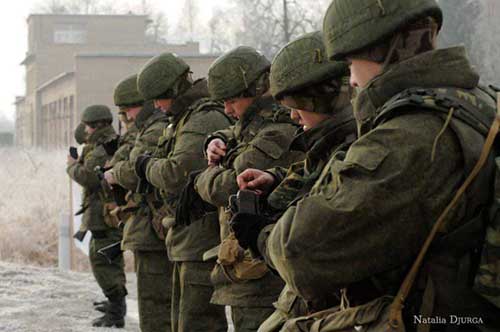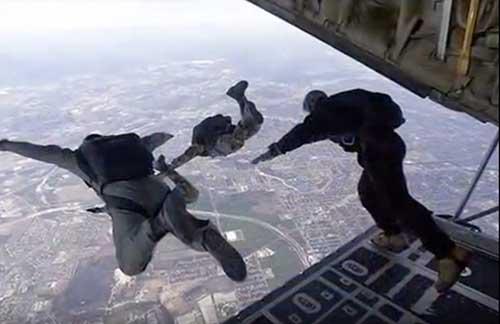Landing a man who falls into the void unharmed is a problem already faced and solved in the middle of the last millennium by forerunners of parachuting such as Sebastiano Fausti, Paolo Guidotti and Fausto Veranzio. And still Italians were the first to register launches made by military personnel during the First World War: the pioneers were Lieutenants Alessandro Tandura and Pier Arrigo Barnaba. For a series of events, however, Italy will have to wait until 1938 to establish the first military unit of paratroopers, moreover in the land of Africa and only partially formed by Italians; even on 1 July 1940 for the creation of the 1st Parachute Battalion.
If Italy can be considered the cradle of the parachute, the Russians must be recognized as true forerunners of the constitution and use of military departments that use them. This latter merit is due to the farsightedness of the general and then Marshal Mikhaïl Toukhatchevski, at the time Chief of Staff of the Red Army. Toukhatchevski at the beginning of the 1930 sent some pilots officers to the USA to study the different types of parachutes in existence at the time used by the Americans. Major Minov was part of this expedition, and on his return to Russia he presented to Marshal Toukhatchevki the idea of using the parachute as a means of transport for units of elite. Marshal Toukhatchevki enthusiastically accepted the proposal and became a fervent supporter: a few months later, on August 2, 1930, the first airborne exercise took place during which 10 paratroopers, under the orders of Lieutenant Mochkovsi, surprised and occupied, following a a launch, the headquarters of the enemy Army Corps. In 1932, the first 450-strong paratrooper battalions were established in Kiev, Leningrad and Moscow.
In Touchino, in the 1933, the first Russian military parachuting school was inaugurated, later also a school for instructors, open to soldiers also from other European nations. In the following years the interest in military parachuting grew significantly thanks to the action of "Osoaviakhim”, An auxiliary organization of the Red Army which was intended to disseminate air sports among young people. In that same period 1000 "jump towers" were built, of which the most famous was located in the Moscow Culture Park.
From the 1934 the departments of paratroopers were equipped with Tupolev TB-3, four-engine transport aircraft equipped with 6 launch doors. In September of the following year, in the Kiev region, the first mass aviation aircraft in the history of military parachuting took place: a fleet of thirty TB-3 launched 1200 paratroopers well. Successive maneuvers with repeated mass launches in the Moscow region, in White Russia, in Transcaucasia and in Central Asia, definitively sanctioned the topicality and the potential effectiveness of the use of airborne troops.
In the 1937 the Russian army counted 100.000 military paratroopers and the first four Brigades VDV, Short for Vozdúšno-desántnye vojská (airborne troops). Numbers that give the absolute evidence of the significant advance with which Russia preceded the world in the use of aviation groups.
During the Second World War the shortage of planes meant that the DVD they were used almost exclusively as infantry troops, while some attempts of employment with throws over the enemy lines had no luck. In September 1941 le VDV they were expanded to 10 Brigades; dissolved and transformed into units of riflemen, artillery and armored vehicles, under the command of General Joludev, took part in the battle of Stalingrad, aggregated to the 1a Guard Army.
In February 1943 were restored to 23 Brigades of VDV for a total strength of 3500–4500 men. They were also used with air forces in operations on the Dnieper front and subsequently, in August 1945, in Manchuria, to take and then to defend the airports of Harbin, Moukden, Kirin and Changchen, just a few days before the end of the Second World War. .
In the post-war period the program to update, upgrade and transform the company began VDV that over the years has brought this specialty of the Russian army to count the current 4 Divisions, of which one is composed of only volunteers, for a total of over 50.000 men. All the Divisions are mechanized, mounted on armored vehicles and therefore characterized by mobility and firepower, much greater than the analogous departments of the other armies.
The level of patriotism and spiritual tension that characterize these departments are inspired by that code of honor and those ideals that are rooted in the most ancient Russian military traditions, always based on values detached from the final outcome of a battle. The VDV they played an important role, often decisive, in many of the war events that involved Russia even after the dissolution of the USSR and can rightly be considered the highest expression of the country's military value.
It was recently announced by Online Defense the decision of the Rome Section of the National Paratroopers Association of Italy to dedicate to the memory of Alexander Prokhorenko the next course for qualification for parachute jump (161 °, expected to start in September 2016 nda). It seems only right in this regard to remember how the young man's protagonist was the gesture Specnaz, of which little or nothing has been reported by the media, has represented only the most recent of the episodes of heroism that have characterized the activity and commitment of Russian paratroopers in arms. 
As another exemplary manifestation of visceral patriotism it is appropriate to recall the battle of Ulus-Kert, during the Second Chechen War. The event contributed not a little to the revival of the Russian military conscience, undermined by the collapse following the implosion of the USSR and the first adventure in the Caucasus in the 90 years.
After the fall of the Chechen capital, a force of over 2000 Chechen guerrillas and foreign fighters Islamists gathered in Ulus-Kert, a small town located 50 km south of Grozny and surrounded by rugged mountainous terrain. In the guerrilla projects there was crossing the mountains towards the south east, to repair in the territory of the partly compliant Republic of Dagestan and thus being able to reorganize itself to resume fighting. The task of encircling the guerrillas and preventing their retreat through the mountains was entrusted to the 104 ° Regiment of the 76a Division VDV. The guerrillas, strong in their knowledge of the territory and a network of local informers, pressed from the north by armored vehicles and regimental artillery, decided to accelerate their retreat through the pass between the 786 and 787 quotas. To the VI a Company parà was given the task of occupying the pass, which, given the harshness of the terrain, could only be reached on foot. Already during his transfer, the Company was engaged in tough clashes with the Chechen vanguards, strong of 150-200 heavily armed men. Although tested by the clashes, the paratroopers reached the goal, hastily preparing the defenses necessary to contain the over 2000 men of the Chechen fighting group, now in contact.
The human losses of the VIa Company, only at the end of the first day of fighting, counted 31 dead and a high number of wounded. To make the situation of the paratroopers even more dramatic were the atmospheric conditions, in particular the fog, which forced the attack helicopters of the regiment to the ground, preventing assistance and cover.
The climate and the violence of the hostilities on the ground could be deduced from the screams that the fighters exchanged on both fronts: at the cry of the Chechens "Allah Akhbar", the Russian paratroopers replied "Christ is risen". By the end of the second day, the casualties rose to 56 and the surviving forces were represented by an officer, Captain Sokolov and 32 paratroopers, almost completely devoid of ammunition. On the third day, in a desperate attempt to curb a new Islamist attack, Captain Sokolov called Russian artillery fire to his positions. The Chechens were again pushed back, but there were another 16 fallen paratroopers on the field. The next day, the fourth and last day of the battle, 11 more paratroopers were killed. When the helicopters and helpers arrived from the sky, which had finally become practicable, of the initial strength of the 90 men of the VI a Company only 6 survivors remained. The position, however, had been maintained.
These paratroopers, like others before them, lacked luck, not honor. After El Alamein, Montecassino, Dien Bien Phu… Ulus-Kert represents a new page of glory in the history of parachuting of our old, a bit tired and confused, but certainly indomitable, continent.
(Adriano Tocchi, president of ANPd'I Rome)
(photo: Airborne Forces)












